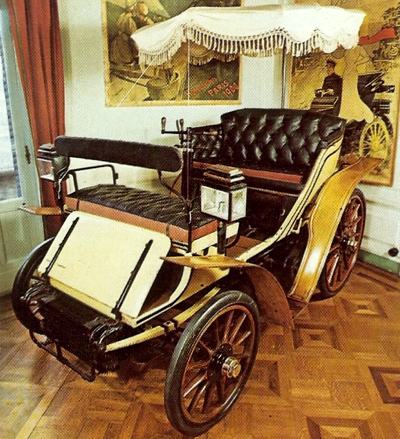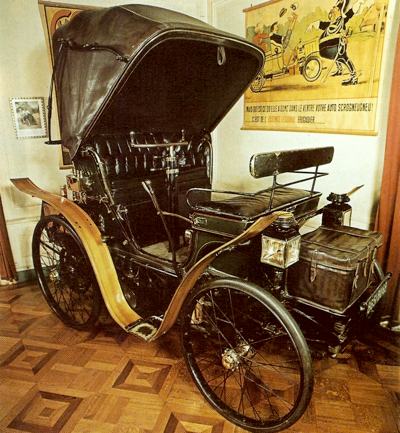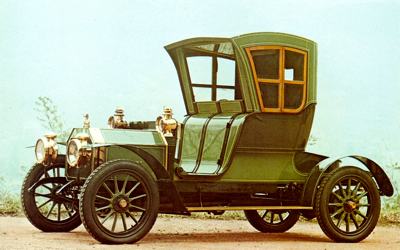In the heyday of motor manufacturing in the French city of Lyon, the most famous make was Rochet-Schneider – but we don’t blame you if you have never heard of them before. Rochet-Schneider was founded in 1889 to build bicycles, a partnership between young Edouard Rochet, a graduate of the Martiniere technical school and the son of the proprietor of a machine shop, and Theophile Schneider, whose family was in the silk trade, one of the traditional industries of the Lyon area.
Demetrius Zafiropulo
Their first car appeared in 1894, based on the contemporary Benz, and by 1896 the partners were confident enough to form a limited company, the Societe Lyonnaise de Velocipedes et Automobiles Rochet-Schneider. Soon the company attracted the attentions of a wealthy Marseilles financier and automobilist, Demetrius Zafiropulo, who made sizeable investments in Rochet-Schneider enabling them to build a new factory in the Chimin Feuilat in Lyon, and helped the company over the difficult period around 1900 when sales of the old belt-driven model began to tail off.
Output had grown from 55 cars in 1898 to 120 in 1899; in 1901, the company introduced new front-engined models, a 7 hp twin and a 12 hp four, with armoured wood chassis, patterned fairly closely on the contemporary Panhard; but at the Paris Salon of 1902 these were replaced by a three-speed 6
½ hp single-cylinder model, a 10 hp twin and a 16hp which followed Mercedes practice closely (apart from the armoured wood chassis), and which was capable of 60 mph.
Your Exhibits are the finest in the Salon
These cars were the sensation of the Salon, at which they were awarded a Gold Medal. President Loubet told the company: 'Your Exhibits are the finest in the Salon', while L'Auto-Velo commented: 'Rochet, in 1903, will be at the head of the Automobile Industry'. Early in 1903, the marque acquired a new British concessionaire, who exhibited it at the motor show organised at the Agricultural Hall, Islington, in March. A particularly good feature of the Rochet-Schneider was the accessibility of the clutch-spring and gear-box, while the engine and flywheel were protected from mud by an aluminium shield.
The Nice Automobile Week Grand Concours
Three
brakes were fitted, the two on the countershaft being water-cooled. By comparison with its excellent quality, the Rochet-Schneider was very moderate in price. Captain Deasy, the new agent, himself described the Rochet-Schneider as 'The smartest car that turns into the park... the gentleman's motor car par excellence.' Unlike most luxury marques of the period, Rochet-Schneider were not that interested in racing, preferring to enter for sprints and hill-climbs, and more leisurely events, such as the Nice Automobile Week Grand Concours for touring cars early in 1903, in which the marque took first, second, fourth and fifth places.
Around the same time, Rochet-Schneider 'gained the Automobile Club of Great Britain and Ireland's 100 Miles Non-Stop Certificate, taking Dashwood Hill at 20.8 miles an hour with four passengers; made a World's Record practically non-stop run of 450 miles, London to Glasgow, in 21 hours; lost one mark only (driver's fault) in the Scottish Non-Stop 400 Miles' Run, Glasgow to London; undefeated, power for power, as a hill-climber - no other car in the world can show such a record tor reliability and hill-climbing.'
 1895 Rochet-Schneider vis-a-vis.
1895 Rochet-Schneider vis-a-vis.
 1898 Rochet-Schneider vis-a-vis. These were based on the contemporary Benz models and were powered by a single cylinder engine.
1898 Rochet-Schneider vis-a-vis. These were based on the contemporary Benz models and were powered by a single cylinder engine.
 1909 Rochet-Schneider cabriolet de ville, powered by a four-cylinder engine.
1909 Rochet-Schneider cabriolet de ville, powered by a four-cylinder engine. |
By 1904, Rochet-Schneiders were being imported into Britain by Morgan Donne, who later also handled Pie-Pie. Two models were offered, a 16/20 hp and a 24/30 hp. A London financier, Philip Horvath, floated a new company, Rochet-Schneider Limited, and acquired the shares of the French company for 4.5 million francs (£180,000); but while the company's registered office may now have been in London, its board of directors remained virtually unchanged. The range of cars offered was widened in 1906; at the Olympia Show that year, Donne & Willans exhibited 16 hp, 18/22 hp, 30 hp, 30/35 hp and 40/50 hp Rochet-Schneiders; there was, apparently, also a 70 hp available.
Voitures de Grand Tourisme
A couple of big sixes were added to the line-up in 1907, of 30/40 hp and 45/60 hp, but it seems that Rochet-Schneider Limited was more adept at raising bank loans than at selling cars, and the rapid expansion of the company's car range without a corresponding increase in sales (these were running at 200-250 annually) was losing them a great deal of money. Coupled with this was a trade recession in 1907-1908, which resulted in the liquidation of Rochet-Schneider Limited at the end of 1907.
The company traded under the aegis of the liquidator during 1908, building cars on a reduced scale, with a total output of around 120. The cars offered were a 'Voiture de Ville' of 12/16hp and four cylinders, and four sizes of 'Voitures de Grand Tourisme': four-cylinder 24/30 hp, 40 hp and 70 hp, and a six-cylinder 30/45 hp.
A new French-financed Rochet-Schneider company was floated at the beginning of 1909; Rochet and Demetrius Zafiropoulo remained on the board, but Schneider was no longer represented. He appeared a year later in Besancon, heading his own new company, Th. Schneider, which manufactured big, fast, dashboard-radiatored tourers and racing cars.
The reformed Etablissements Lyonnais Rochet-Schneider prospered, not least because of the company's acquisition, in mid-1909 of the Zenith Carburettor Company. The carburettors were produced in a factory adjacent to Rochet-Schneider in the Chemin Feuillat, and also in branch factories in Germany, Britain and Detroit, and were obligatory wear on many of the luxury vehicles of the day.
French President M. Poincare
Car production was rising, too: in 1910, some 400 Rochet-Schneiders were produced, though it seems that the day of the big roadsters was over. In 1909 only seven 40 hp, three 70 hp, ten 30 hp (six-cylinder) and nine 45 hp (also a six) were built; in 1910 ten 70 hps and two 40/50 hps were produced, and thereafter the company concentrated on cars of more modest cylinder capacity.
At the 1910 Paris Salon, Rochet-Schneider offered 'Chassis et Voitures Automobiles a quatre et six cylindres, 12,18,25 et 28hp', and it was one of the new 25hps which was acquired in 1911 by the French President, M. Poincare.
Production rose to 600 cars that year; but for the first time for almost a decade, Rochet-Schneider were not exhibiting at the London Motor Show. They reappeared at Olympia in November 1913, when Automobiles Rochet-Schneider of London, exhibited a solitary 30/40 hp car (an overbored version of the 25 hp), which had pressure lubrication, a horizontal Zenith carburettor, and a chassis underslung at the rear.
Although in many ways the Rochet-Schneider had advanced features, the company stuck with distinctly old-fashioned feature of non-detachable artillery wheels. The full 1914 range consisted of six cars from 15 to 60 hp, of four or six cylinders.
La Voiture de Qualite
There was little progress in design after the war, though Donne & Willand, who had dropped Rochet-Schneider for Piccard-Pictet around 1910, now resumed the British agency. But the 'latest improvements' promised in the agency's advertising were little more than the addition of an electric lighting and starting outfit and a
tyre inflator pump fitted to the gearbox.
The 2.6-litre 15.9hp, the 4-litre 22.4hp and the 6.1-litre 37.2hp were all similar to their pre-war counterparts, a fact which the company sought to disguise under their new slogan 'La Voiture de Qualite'. A distinguished Vee-radiator was fitted in place of the severely square-cut cooler of pre-war days. Chassis prices at this time were 25,000 Fr for the 2.6-litre, 32,000 Fr for the 4-litre and 65,000 Fr for the 6.1-litre.
Many Rochet-Schneiders of the epoque were fitted with somewhat unexciting coachwork by Billeter & Cartier, whose factory was next-door to Rochet- Schneider; but the cars could also be specified with the very finest bodies from companies like Million-Guiet. Some degree of mechanical progress was noted in 1923, when a 'sports' version of the 4-litre appeared, with overhead valves and, like the side-valve version of this chassis, which was still produced, four-wheel braking.
In 1925 the 2.6-litre also acquired ohv, while a new small six of 3.75 litres appeared, but the cars continued to be expensive and luxurious. Their last-and perhaps their finest-model appeared in 1930. This was the 4.5-litre 26hp six, with pushrod ohv, dual ignition and a twin-choke Zenith carburettor. It was not, however, a car for the depression, and production ceased in 1931. Rochet-Schneider had, however, been making commercial vehicles for many years, and from 1932 on concentrated production on this hitherto modestly publicised side of its activities.
In
1951 Rochet-Schneider was acquired by Berliet, and the marque name vanished a couple of years later, when the works in the Chemin Feuillat became no more than a warehouse.



